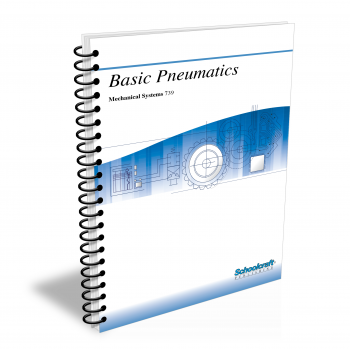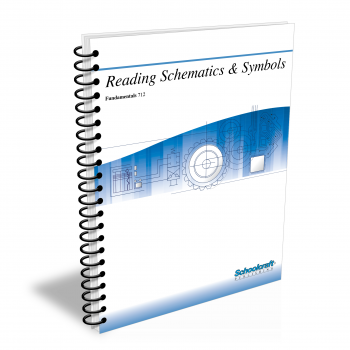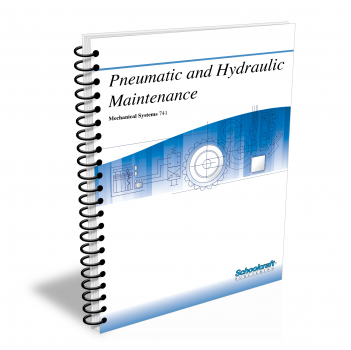Basic Pneumatics

Course Number: 739
The Basic Pneumatics textbook begins with a chapter on the relationships among pressure, force, work, and energy, this course then goes on to describe the operation of both reciprocating and rotary compressors. Chapters on primary and secondary air treatment explain lubrication and the removal of water, oil, and contaminants from the compressed air. Following chapters deal with system components, including piping, valves, cylinders, and motors. This textbook is a prerequisite for the 740 textbook on Pneumatic Troubleshooting.
Does your curriculum require additional topics not included in this textbook? Build a customized version of the Basic Pneumatics textbook below.
This textbook has been recently updated
to include topics lists, objectives, & key terms for every chapter.
Recommended Contact Hours – 15
Preview a Chapter
Available Supporting Material
- Table of Contents
- Exam Copies
- Suggested Titles
Table of Contents
Chapter 1: Principles of Pneumatics
Topics: Fluid power systems; Force, weight, and mass; Pressure; Work and energy; Diffusion and dispersion; Compressibility; Laws of pneumatics; Leverage; Air properties and flow; Bernoulli's Law; Components
Learning Objectives:
- Explain how force is transmitted in a pneumatic system.
- Calculate force and work.
- List two factors that affect the results of pressure calculations.
- Explain pneumatic leverage.
- Briefly explain the physical laws affecting the behavior of a confined gas.
Chapter 2: Reciprocating Compressors
Topics: Compressor construction, classification, and operation; Single-, double-acting compressors; Cooling requirements; Lubrication; Controls
Learning Objectives:
- Differentiate between a positive-displacement compressor and a dynamic compressor.
- Describe the operation of a reciprocating compressor.
- List one advantage of using a multistage compressor.
- Identify the cooling arrangements for reciprocating compressors.
- Compare the operation of compressor controls in large and small units.
Chapter 3: Rotary Compressors
Topics: Vane, rotary-screw, low-pressure, high-volume, diaphragm, centrifugal, and axial-flow compressors; Compressor capacity; Accessories
Learning Objectives:
- Compare the power output of a single-stage vs a two-stage vane compressor.
- Describe the main types of positive-displacement rotary air compressors.
- Explain the advantages and disadvantages of both types of dynamic compressors.
- Describe four methods of controlling centrifugal compressor output.
- Tell how to compensate for a low-speed drive in rotary screw compressors.
Chapter 4: Primary Air Treatment
Topics: Preliminary filtering; Relative humidity; Effects of moisture; Moisture separators; Oil scrubbers; Air dryers and receivers; Using a nomograph
Learning Objectives:
- Describe techniques for cleaning compressor filters.
- Define relative humidity and dew point.
- Explain the effects of temperature and pressure on the air's ability to hold moisture.
- Describe aftercooler operation.
- Explain the functions of separators, oil scrubbers, and air dryers.
Chapter 5: Secondary Air Treatment
Topics: Contaminant separation and filtration; Filter classification and rating; Surface, depth, adsorption, and absorption filters; Lubricating the air
Learning Objectives:
- Describe the two main methods of contaminant separation.
- Explain how filters are classified.
- List contaminant particle sizes and particle contamination categories as they occur in filters.
- List applications for the most common types of filter media.
- Identify system location for lubrication equipment installation.
Chapter 6: Piping, Hoses, and Tubing
Topics: Piping requirements and dimensions; Safety; Connections; Metallic tubing; Tube bending, fittings, and installation; Hoses, fittings, and installation
Learning Objectives:
- State the importance of laminar flow.
- List the factors that affect pressure loss in a pipe.
- State direction and amount of slope for compressor discharge pipes.
- Discuss procedures for pipe, tube, and hose installation.
- Describe safe working procedures for disconnecting air hoses.
Chapter 7: Directional Control Valves
Topics: Manually and automatically operated valves; Control valve elements: spools, poppets, disks, and plates; Two-, three-, four-, and five-way valves; Accessories
Learning Objectives:
- Describe the four methods of identifying control valves.
- List four basic types of manually operated, two-way valves.
- Describe the operation of a two-position, direct acting, normally closed solenoid valve.
- Explain one major advantage of using a four-way valve.
- Describe the construction of a three-way valve.
Chapter 8: Pressure-Control Valves
Topics: Safety vs relief valves; Relief valve construction; Pressure regulators; Pilot-operated, remote-controlled regulators; Logic functions
Learning Objectives:
- List two ways a valve can control compressor pressure output.
- Describe construction of two basic types of pressure-relief valves.
- Contrast a pressure regulator with a pressure-relief valve.
- State the limit imposed by Federal Law on the pressure allowed when an air hose is used to blow off chips.
Chapter 9: Pneumatic Cylinders
Topics: Double-, single-acting cylinders; Two-piston cylinders; Cylinder construction, mounting, and selection; Performance charts; Cushioning
Learning Objectives:
- Tell the difference between pneumatic and hydraulic cylinders.
- Describe the construction and operation of a single-acting cylinder.
- State the purpose of an exhaust flow control metering valve.
- Describe the action of a pivoted cylinder.
- Explain the size relationship between a cylinder port and a valve port.
Chapter 10: Pneumatic Motors
Topics: Motor rating; Selection factors: pressure, speed, torque, horsepower, reliability, and service life; Rotary vane and piston motors; Air boosters
Learning Objectives:
- Explain pneumatic motor classification.
- Define torque.
- Describe pneumatic motor construction.
- Calculate a motor's horsepower, given its torque and speed.
- Differentiate between a pneumatic motor and a rotary actuator.
Request Exam Copies
Exam Copies
Ready to see a copy of our textbooks? After selecting which textbooks you’d like to review for your course, you can submit your request by either logging in or creating an account so we know where to ship your exam copies. A representative from Schoolcraft will contact you to confirm and finish processing your request.
Exam copies are always free and yours to keep.
Selected Exam Copies
none selected
* Maximum of five copies can be ordered


